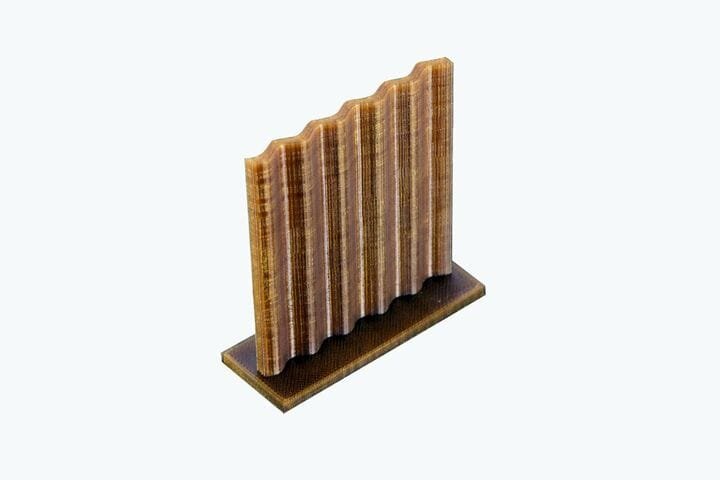![Sample 3D print of EXTEM AMHH811F material [Source: ROBOZE]](https://fabbaloo.com/wp-content/uploads/2020/05/image-asset_img_5eb08d74585d2.jpg) Sample 3D print of EXTEM AMHH811F material [Source: ROBOZE]
Sample 3D print of EXTEM AMHH811F material [Source: ROBOZE]
ROBOZE introduced a brand new filament that just happens to have the highest heat resistance of any 3D printer filament today.
EXTEM AMHH811F Filament
The new material was jointly devised by ROBOZE and their partner, chemicals giant SABIC. It’s called “EXTEM AMHH811F Filament”, and is intended for use in ROBOZE’s industrial ARGO series of high temperature 3D printers.
The material is a “semi-transparent thermoplastic polyimide (TPI)” that happens to also exhibit great flame resistant properties.
EXTEM AMHH811F Filament Heat Resistance
How high is the temperature resistance? ROBOZE says it has a heat deflection temperature of 230C, with a glass transition temperature of 247C, both very high values, approximately 30C higher than ULTEM, a popular high temperature material used widely. ROBOZE explains:
“The material offers an extremely high performing ignition resistance, retains mechanical strength at high temperatures, has good chemical resistance and offers inherent flame retardancy. The material is RoHS compliant and halogen free, according to VDE / DIN 472 part 815.”
![ROBOZE’s EXTEM AMHH811F position in the material hierarchy [Source: ROBOZE]](https://fabbaloo.com/wp-content/uploads/2020/05/image-asset_img_5eb08d74a3be0.jpg) ROBOZE’s EXTEM AMHH811F position in the material hierarchy [Source: ROBOZE]
ROBOZE’s EXTEM AMHH811F position in the material hierarchy [Source: ROBOZE]
SABIC’s senior business manager for Additive Manufacturing, Keith Cox, said:
“It’s been exciting to collaborate with ROBOZE to become the exclusive supplier of EXTEM™ AMHH811F filament for use on the ARGO platform. Our companies share the same enthusiasm to grow the AM market by making new high performance materials available to customers whose applications require the performance that can only be delivered by EXTEM™ filament on the new ARGO 3D printer. We hope that this is the first of many such exclusive collaborations with ROBOZE.”
There’s a couple of things to be said about this development.
High Temperature 3D Printing Capability
First, the availability of a new even-higher temperature 3D print material will be welcome news for many manufacturers. One of the main barriers to adoption of 3D printing for specific part production has been the unavailability of suitable materials. The result of this constraint is that there is a subset of possible parts capable of being 3D printed.
With the new material properties of EXTEM AMHH811F Filament, that envelope of possibilities is now increased in size. More parts can now be 3D printed.
It’s quite possible there are applications where high-temperature parts are required, but currently not 3D printed due to the lack of an appropriate material.
Increasing Use of Additive Manufacturing
Secondly, this is part of the continuing push by the additive manufacturing industry to increase the scope of activities. New equipment, materials, processes and other aspects are constantly being improved by vendors worldwide, all leading to a much expanded future for 3D printing technologies.
While the new material is for now exclusively available through ROBOZE for use on their ARGO equipment, it is not yet known if EXTEM AMHH811F Filament can be 3D printed on other equipment, should ROBOZE decide to sell it to non-ROBOZE clients.
But for many operations, the requirement for a specific material often drives the purchase of equipment. Many times I have heard engineers commenting about 3D printing equipment:
“If it doesn’t 3D print [required material], I am not interested in buying it.”
This material could be a way for ROBOZE to sell a lot more ARGO equipment.
The company intends on showing sample prints to the public at Formnext in a few weeks, and it is not yet clear when EXTEM AMHH811F Filament will be available for purchase.
Via ROBOZE

